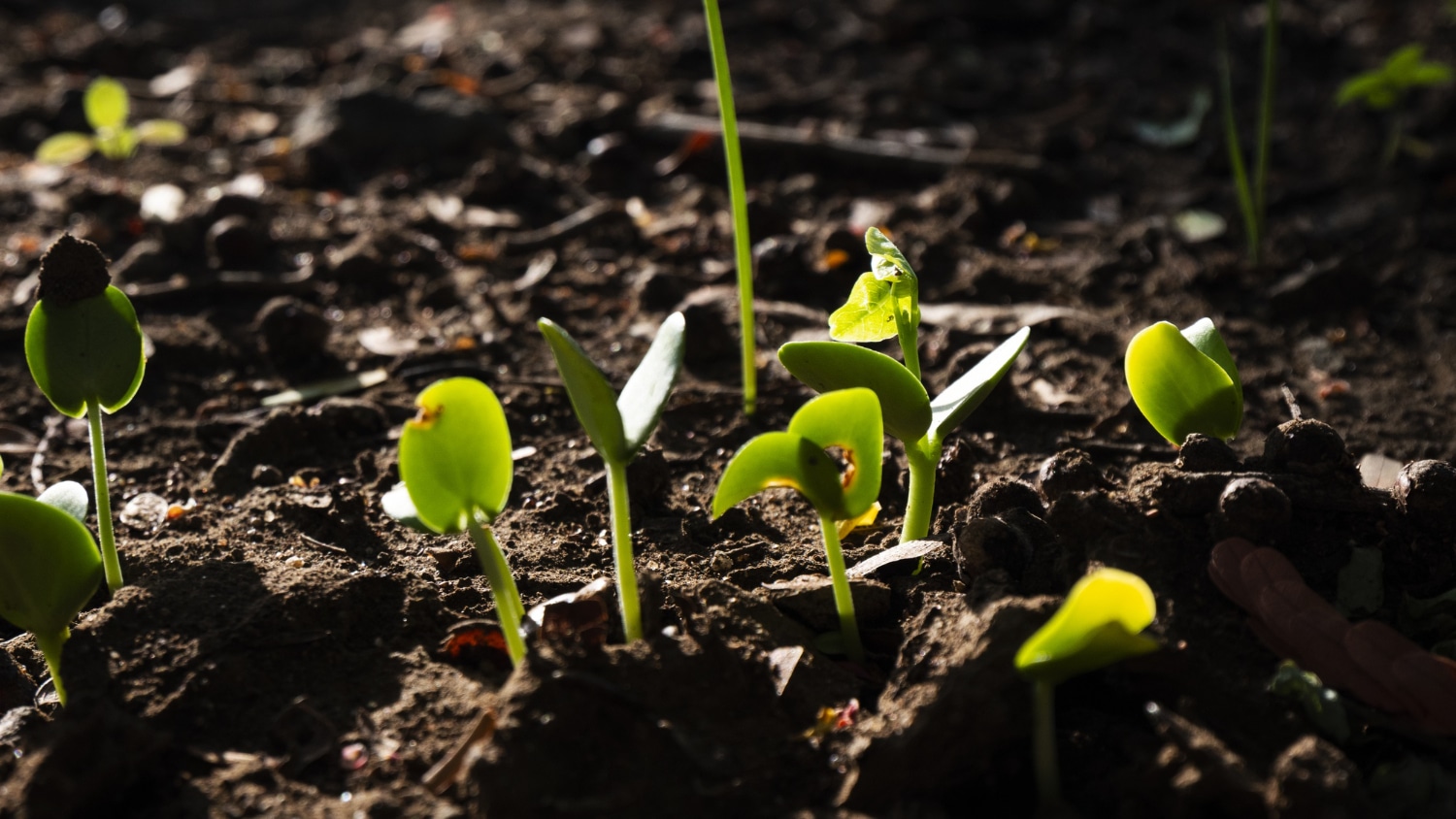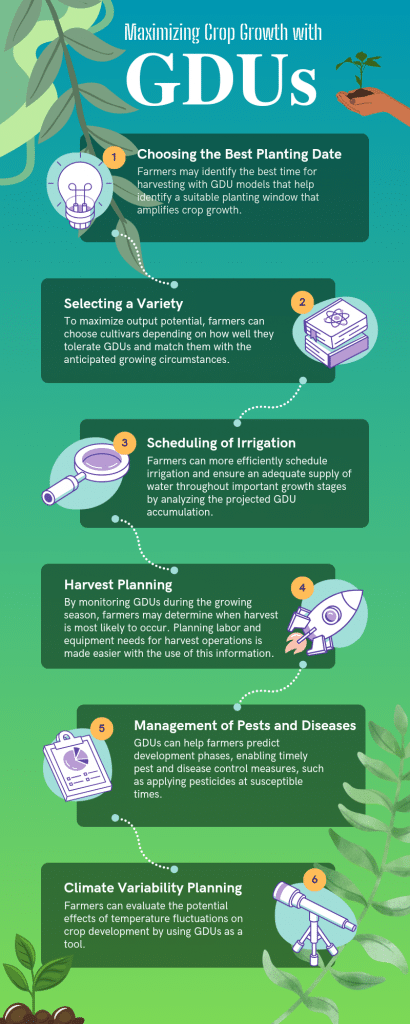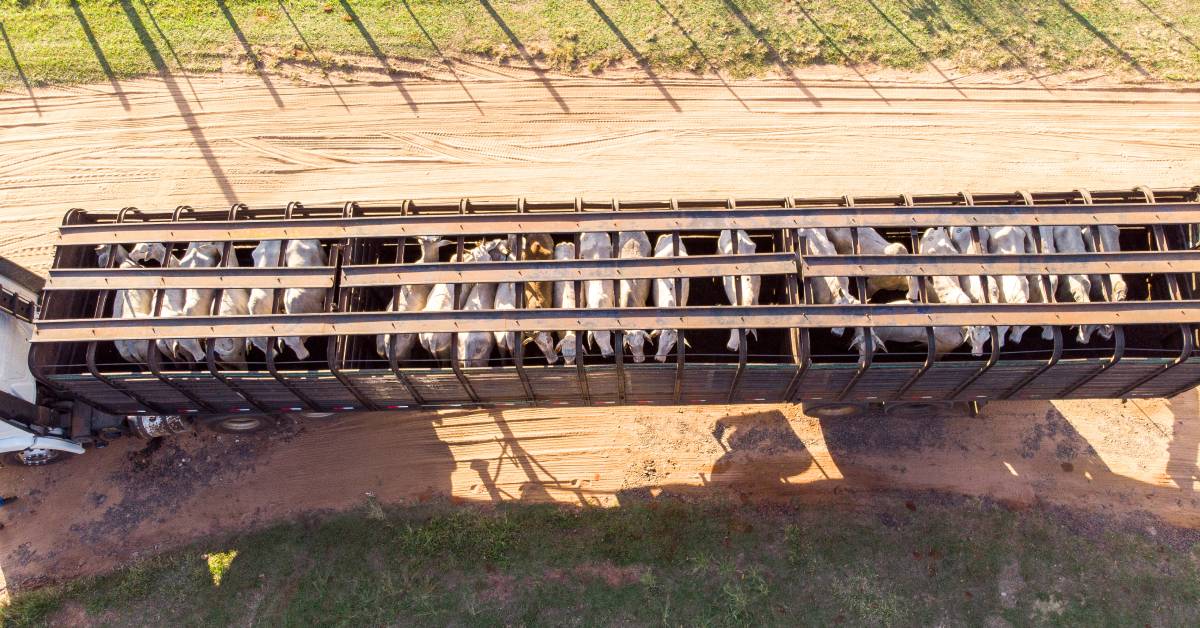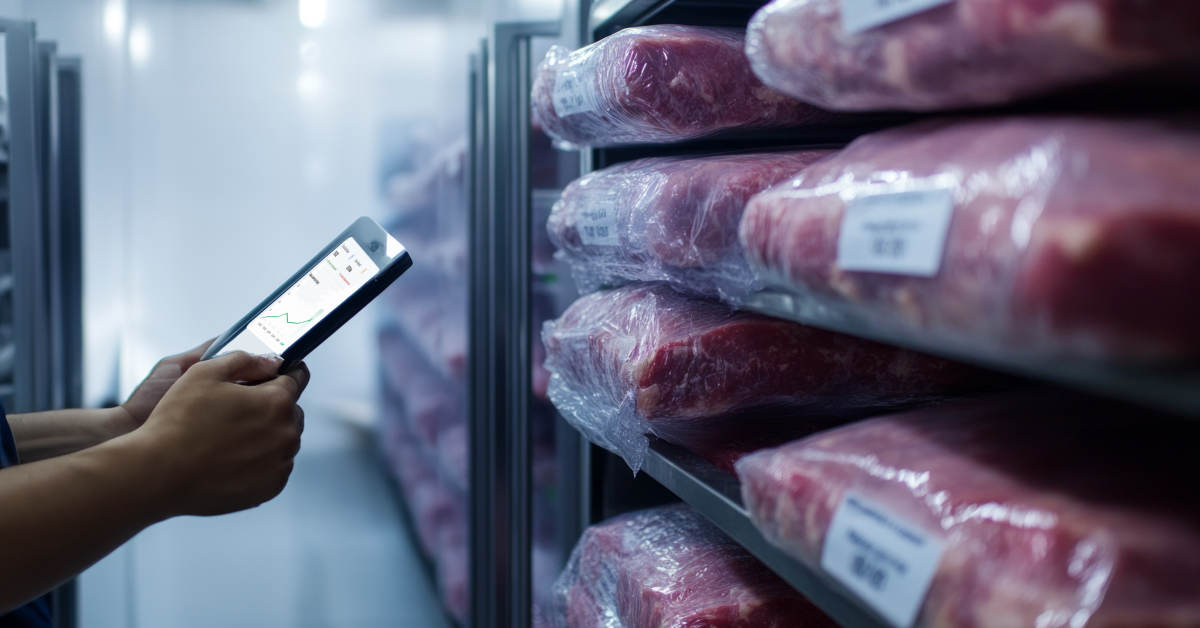Growing Degree Units (GDUs) are becoming more than just measures in today’s agricultural landscapes; they are becoming essential instruments that influence the accuracy and productivity of farming practices.
Crop growth and GDUs are at the vanguard of agricultural innovation, redefining the parameters by which farmers assess and forecast the growth of their crops. GDUs symbolize the accumulated heat essential for crop development. This crucial parameter functions as a quantitative measurement, providing a detailed understanding of the complex link between crop development and temperature throughout the growing season.
GDU calculation is crucial in agriculture for accurate crop development predictions. It provides farmers with information on the amount of time heated to critical developmental stages, impacting crop phenology and determining seasonal and cyclical events.
A revolutionary change toward data-driven decision-making is indicated by the use of GDU calculators in agriculture and contemporary farming methods.
Growing Degree Units (GDUs) contribute to a comprehensive awareness of growing conditions by integrating seamlessly with related concepts like crop heat units (CHUs), even beyond their immediate use. Not only does this integration improve crop modeling forecasts, but it also gives farmers the flexibility to maximize agricultural productivity and sustainability by optimizing planting and harvesting schedules.
As a precise and predictive lens that helps farmers traverse the complexity of crop management, Growing Degree Units (GDUs) have essentially become the cornerstone of modern agriculture.
What are Growing Degree Units?
Definition of GDUs
Growing Degree Units (GDUs) are a unit of measurement used to assess the buildup of heat over time. Crops and other biological creatures are subjected to a cumulative amount of heat energy during their development, which is represented by GDUs.
These units are pertinent when anticipating and comprehending the growth and development of crops throughout the growing season.
Scientific Basis of GDUs
Here’s how GDUs function and the agricultural context in which they matter:
1- Base Temperature
Every plant species has a minimum temperature below which it does not acquire GDUs. This temperature is usually approximately 50°F (10°C), and it is considered the minimum at which biological activity can occur.
2- Calculation of GDUs
The base temperature is subtracted from the average daily temperature to determine the GDU. The positive value of the results is then added up over time. GDU = (Max Temp + Min Temp) / 2 – Base Temperature is a common expression for the formula.
3- Temperature and Biological Processes
Temperature affects the rate of biological processes like germination, growth, and reproduction, with warmer temperatures causing faster processes and colder temperatures slowing them down.
4- Crop Development Stages
Farmers can predict development stages in crops like maize by tracking GDUs, which are linked to emergence, germination, flowering, and grain filling.
5- Predictive Tool
GDUs help farmers and agronomists make informed decisions on planting dates, crop selection, irrigation timing, and pest management by tracking temperature data and computing GDUs.
6- Management Choices
GDUs aid in agricultural tasks like planting and harvesting, enabling farmers to adjust tactics based on heat buildup to ensure optimal crop growth conditions.
How To Calculate GDUs?
GDU Calculation Methodology
There is a simple method that takes daily temperature data into account when calculating Growing Degree Units (GDUs). Each crop has a base temperature, and the formula is meant to measure the total amount of heat accumulated over that temperature. An outline for GDU calculation can be found here:
The formula for GDU Calculation:
GDU = (Daily Maximum Air Temperature + Daily Minimum Temperature)/2 – 50.)
Step-by-Step Guide for GDU Calculations
1- Choose a Base Temperature:
Determine the base temperature for the crop you’re monitoring, typically 50°F (10°C), and consult literature or advice for specific information.
2- Gather Daily Temperature Information:
Compile daily temperature data for the area and time frame of interest. This usually contains the highest and lowest temperatures noted for each day.
3- Use the GDU Formula:
Apply the GDU formula for each day as follows:
GDU = (Daily Maximum Air Temperature + Daily Minimum Temperature)/2 – 50.)
The daily GDU value is obtained from this calculation.
4- Build Up Your GDUs Gradually:
The cumulative GDU value for a crop is calculated by adding daily GDU numbers to the total during the growing season.
5- Track the Stages of Crop Development:
The cumulative GDU number is used to gauge the crop’s progress through growth stages like emergence, flowering, maturity, and germination, with specific requirements for each stage.
6- Reset the Total at the Beginning of Every Growing Season:
Set the cumulative GDU value to zero at the start of each growing season. By doing this, the computation is guaranteed to account for the heat accumulation during the current season.
Example:
Let’s consider a hypothetical scenario with daily temperature data for a corn crop:
Day 1: Max Temp = 75°F, Min Temp = 55°F
Day 2: Max Temp = 80°F, Min Temp = 60°F
Day 3: Max Temp = 70°F, Min Temp = 50°F
Assuming a base temperature of 50°F
GDUDay 1=275+55−50=27.5
GDUDay 2=280+60−50=35
GDUDay 3=270+50−50=20
Throughout the growing season, we can utilize the total number of GDUs accumulated to measure the crop’s progress through several phases.
Keep in mind that this is an oversimplified example; real GDU computations may require extra factors, such as adjusting for upper-temperature cutoffs and truncating negative numbers to zero.
Use Cases of GDUs in Crop Farming
Determining Planting Times
1- Crop-Specific Planting Guidelines
GDUs are essential in figuring out when to plant different crops. Specific GDU needs are needed for early growth and germination in different crops. Based on past climate data, farmers can use collected GDUs to determine the ideal planting window.
2- Risk management
Farmers can evaluate the likelihood of late spring or early autumn frosts by monitoring GDUs. They can also determine when to begin planting to reduce the chance of frost damage during crucial growth phases by monitoring the accumulated heat units.
Predicting Harvest Dates
1- Days to Maturity Estimation
Using GDUs, farmers may calculate how long a crop will take to mature. This information benefits both predicting harvest dates and effectively organizing harvesting operations.
2- Ideal Harvest Timing
GDUs give farmers information on the crop’s developmental stage, which aids in selecting the best harvest time. Harvesting at the optimal time guarantees a higher yield and higher-quality crop.
3- Adapting to Climate Variability
GDUs provide a means of temperature adaptation in areas with erratic climates. Based on the total heat units, farmers can modify their harvest plans to account for changes in weather patterns.
Optimizing Crop Management Strategies
1-Scheduling of Irrigation
GDUs enhance irrigation efficiency by monitoring moisture buildup, enabling farmers to plan irrigation schedules and forecast water requirements during critical growth stages.
2- Fertilizer Application
GDUs help design fertilizer schedules by indicating growth stages requiring higher nutrient availability, influencing crop development, and ensuring optimal fertilizer application timing.
3- Timing of Pest Control
GDUs predict pest and disease stages during crop growth, enabling timely pest treatment. Monitoring helps identify potential hazards during flowering and sensitive stages.
4- Heat Stress Management
GDUs help in managing heat stress in agriculture by assessing heat accumulation and implementing strategies like planting dates and heat-tolerant types to mitigate its negative impact on crop development.
Understanding Growing Degree Days
What are Growing Degree Days (GDD)?
Growing Degree Days (GDDs) are crucial for crop growth in agriculture. They provide a quantitative measure of the thermal time needed for developmental stages, thereby optimizing farming practices.
In essence, GDD is a temperature-based calculation, more precisely, the difference between the base temperature and the average daily temperature. The base temperature, which is usually around 50 degrees Fahrenheit, is the lowest threshold needed for crop growth.
The idea of GDD is a useful tool for Predicting crop development with GDUs since it gives farmers information about the cumulative heat units that affect the growth process.
GDD has become a pillar in the field of GDU calculation in agriculture. It is a dynamic metric that takes into account the length and size of temperature variations from the base, giving rise to a more complex understanding of how temperature affects crop phenology.
GDDs and crop temperature have a complex interaction, with the amount of heat that accumulates affecting the length and timing of the growing season.
Farmers leverage GDD calculators in farming to:
- Streamline decision-making processes,
- Optimize planting
- Organize harvest schedules based on real-time data.
The addition of related concepts, such as Crop Heat Units (CHUs), enhances comprehensive crop modeling and further refines the assessment of growing conditions.
GDD and thermal time are essential for effectively navigating the intricacies of agricultural management. They provide a scientific method for maximizing crop output and guaranteeing sustainability in the face of shifting growing season temperatures.
Significance of GDD in Crop Growth
Growing Degree Units (GDUs) are a vital tool in agriculture. They act as a crucial indicator for tracking temperature thresholds that are essential for different phases of crop growth.
Farmers must grasp the significance of GDUs as they maneuver through the complexities of maximizing crop development during the growing season temperature.
GDU calculations in agriculture are essential for proactive crop management. Farmers can precisely evaluate the collected heat units by using Growing Degree Units, which provide a quantifiable measurement that helps with decision-making during the entire cultivation process.
Predicting crop development with GDUs becomes more precise, allowing farmers to anticipate temperature-related challenges and opportunities.
GDUs’ function in monitoring temperature thresholds, particularly in various crop growth phases, is one of the main advantages. The necessary thermal time varies as crops develop from germination to flowering and maturity. As a dependable indicator, GDUs assist farmers in:
- Determining the best times to plant
- Identifying potential constraints on productivity.
Due to the dynamic nature of GDUs and crop temperature, farmers can adjust their cultivation practices throughout the growing season to meet the specific needs of various crops.
GDU calculators in farming offer a useful tool for incorporating Growing Degree Units into routine decision-making. These calculators enable farmers to make well-informed decisions on real-time data about:
- Irrigation
- Fertilization
This helps streamline the challenging process of tracking and understanding GDUs. The understanding of how temperature affects crop phenology is further refined by incorporating related concepts like Crop Heat Units (CHUs).
GDUs help in crop modeling, enabling farmers to predict temperature changes and make necessary adjustments, ensuring optimal crop growth. They manage:
- Temperature interactions
- Production levels
- Sustainability
Tracking Corn Development With GDUs
Within Cutoff Temperatures
Growing Degree Units (GDUs) are crucial in agriculture for monitoring crop development and heat accumulation. Temperature significantly impacts maize growth, and crops require specific heat for different growth phases.
This is a broad summary of how GDUs within particular temperature ranges affect crop development:
1- Base Temperature:
Below a certain temperature, crops do not accumulate GDUs. This basic temperature for maize is usually approximately 50°F (10°C). The plant is practically dormant below this temperature, and GDUs do not build up.
2- Ideal Temperature Range
There is a range of temperatures where maize grows and develops most effectively. This range is normally 77°F to 95°F (25°C to 35°C) for maize. The physiological functions of the plant, including photosynthesis and nitrogen uptake, are optimized within this range.
3- Accumulation of GDUs
To compute GDUs, take the daily average temperature, deduct the base temperature, and add up the positive variations over time. GDU = (Max Temp + Min Temp) / 2 – Base Temperature is a common expression for the formula.
4- Impact on Growth Stages
Corn has distinct temperature needs for each stage of growth, including germination, vegetative growth, flowering, and grain filling. Estimating when these stages will occur is made easier by tracking GDUs.
5- Impact of Early Season
Corn growth is more temperature-sensitive early in the season, and GDUs are important in selecting when to plant and emerge. Sufficient GDUs guarantee prompt development and have the ability to affect total yield.
6- Impact on Late Season
The accumulation of GDUs continues to affect potential yield during the reproductive phases, especially during blooming and grain filling. During these phases, proper pollination and grain fill depend on sufficient heat.
7- Management Strategies
To maximize maize development, farmers and agronomists can utilize GDU models to help them make educated decisions about when to plant, which varieties to choose, and other management techniques.
Below is the Base Cutoff Temperature
When the temperature falls below the basic cutoff temperature, which is usually approximately 50°F or 10°C, several consequences affect the growth phases and development of maize.
Here are some crucial things to remember:
1- Dormancy and Delayed Germination
Corn stays dormant below the base temperature. Seeds may not sprout until the temperature reaches a level that is conducive to active growth, as germination is a delayed process.
2- Restricted Root Development
In general, colder temperatures cause roots to grow more slowly. Both fertilizer intake and general plant establishment may be impacted by this. Sufficient root development is necessary for the absorption of nutrients and water.
3- Early Growth and Delayed Emergence
Seedlings may experience delayed emergence due to cool temperatures. Early growth of young plants can be sluggish, which can impact the formation of the first leaves and stems.
4- Extended Vegetative Stage
An extended vegetative stage may result from repeated exposure to temperatures below the base cutoff. As a result, the plant takes longer to reach reproductive phases like blossoming and tasseling.
5- Effect on Pollination
Pollination may be adversely affected by cold temperatures during the flowering season. It might lead to inadequate ovule fertilization, decreased pollen viability, and poor silk development, all of which could decrease kernel formation and yields.
6- Frost Damage Risk
Young crop plants are susceptible to frost damage in extremely cold weather. When maize is still in its early phases of growth, frost can injure plant tissues, which can result in slowed growth or even plant mortality.
7- Decreased Photosynthesis and Energy Production
At lower temperatures, photosynthesis—the process by which plants turn sunlight into energy—is less effective. Reduced energy generation for development and growth may come from this.
Above High Cutoff Temperature
Temperatures beyond the high cutoff for crop development, which is usually 35°C or 95°F, can have a substantial effect on different phases of growth and maturation. Here are some crucial things to remember:
1- Reduced Photosynthesis and Heat Stress
High temperatures can cause heat stress, which lowers the effectiveness of photosynthesis. To save water, the plant may block its stomata, which would lower its intake of carbon dioxide and make it more difficult for it to absorb sunlight and produce energy, resulting in lesser overall growth.
2- Development Accelerated
Higher temperatures have the potential to speed up maize development in particular circumstances. This may result in a faster time to maturity, which could have an impact on how long crucial growth phases last. If a plant develops quickly, it does not have enough time to realize its full potential, which could lead to smaller plants and lower production.
3- Reduced Grain Fill Period
During the grain-filling stage, an excessive amount of heat might limit the amount of time that is available for kernel growth. This may result in lighter, smaller kernels from insufficient grain filling, which will ultimately affect yield.
4- Decreased Pollen Viability
During the flowering season, high temperatures can have a detrimental effect on pollen viability. Pollen quality reduction can lead to inadequate ovule fertilization, which can cause a decrease in kernel set and possible yield loss.
5- Reduced Water Use Efficiency
Higher evapotranspiration rates are generally the result of increased water demand brought on by high temperatures. Water stress in maize may occur more quickly, particularly in areas where water is scarce. Increased heat-related stress can be compounded by inefficient use of water.
Predicting Crop Development Using Growing Degree Units
Here are some examples of how crop development timeframes can be planned using GDUs to estimate and predict crop growth phases and maturity:
GDUs in Predicting Crop Growth
1- Temperature Influence on Growth
GDUs measure the daily temperatures of crops, indicating plant development’s acceleration or slowdown. Farmers can track growth stages by collecting GDUs throughout the growing season.
2- Base Temperature and Development Thresholds
Crops have a base temperature that prevents growth. This temperature is calculated by subtracting the daily average temperature from it, allowing for expected events like flowering or maturity.
3- Crop-Specific Models
GDU-based crop models illustrate temperature effects on crop development, providing predictions based on temperature data.
4- Days to Maturity Estimation
Farmers can track GDUs from planting to maturity, enabling them to plan harvest timings and evaluate the entire growing season.
Utilizing GDUs for Crop Development Timelines
1- Choosing the Best Planting Date
Using GDU models, farmers may identify the best time to plant a particular crop. They can select a planting window that maximizes crop development by taking into account the projected accumulation of GDUs and the typical historical temperature.
2- Selecting a Variety
The GDU needed to reach maturity may vary throughout crop varieties. To maximize output potential, farmers can choose cultivars depending on how well they tolerate GDUs and match them with the anticipated growing circumstances.
3- Scheduling of Irrigation
GDUs can affect how much water crops demand. Farmers can more efficiently schedule irrigation and ensure an adequate supply of water throughout important growth stages by analyzing the projected GDU accumulation and linking it with crop water needs.
4- Harvest Planning
By monitoring GDUs during the growing season, farmers may determine when harvest is most likely to occur. Planning labor and equipment needs for harvest operations is made easier with the use of this information.
5- Management of Pests and Diseases
GDUs can help farmers predict development phases, enabling timely pest and disease control measures, such as applying pesticides at susceptible times.
6- Climate Variability Planning
Farmers can evaluate the potential effects of temperature fluctuations on crop development by using GDUs as a tool.
Benefits of Using GDU Calculators in Crop Farming
Enhanced Precision in Farming Practices
1- Accurate Measurement of Heat Units
GDU calculators provide precise and precise measurements of accumulated heat units, enhancing the reliability of temperature-based crop development calculations.
2- Crop-Specific Tailoring
GDU calculators enable farmers to customize their agricultural strategies for specific crops, ensuring they grow in the ideal temperature ranges, thereby enhancing their productivity.
Efficiency in Crop Management
1- Optimized Planting Dates
By taking accumulated heat units into account, GDU calculators help determine ideal planting dates. Better synchronization between planting and ideal growing conditions may arise from this optimization, which will help with crop establishment.
2- Timely Harvest Planning
By estimating days to maturity using GDU calculators, farmers may effectively schedule harvest activities. This allows harvest to be timely and efficient, avoiding delays that can cause overripening or a decline in quality.
3- Resource Allocation
GDU calculators make it easier to use resources effectively. By matching resources—such as labor, machinery, and inputs—with the several growth stages denoted by accumulated GDUs, farmers can allocate resources more efficiently.
Conclusion
Crop growth and GDUs are essential because they give farmers the ability to make precise decisions. Through their precise detection of accumulated heat, the following processes are made more efficient:
- Planting
- Harvesting
- Resource distribution
Through practice optimization, risk mitigation, and the promotion of adaptive management, GDUs support sustainable farming.
Better yields and the general sustainability of agricultural systems are supported by GDUs, a useful tool in the farmer’s toolbox that encourages robust and effective crop management software solutions.
Stay Rooted, Grow Informed:
Subscribe to Agtech
Brilliance Now!
Unlock Exclusive Insights, Innovations, and Agribusiness Wisdom – Join Us Today!
FAQ Questions:
Q- How do GDUs affect crop growth?
GDUs positively influence crop growth by quantifying accumulated heat and optimizing developmental stages.
Q- What is the relationship between GDUs and crop phenology?
GDUs correlate with crop phenology, tracking heat accumulation to predict growth stages.
Q- What temperatures are considered for GDU calculations?
Daily temperatures are taken into account in GDU calculations in agriculture, with the base temperature for certain crops subtracted.
Q- Can GDUs predict crop maturity?
Yes, GDUs can predict crop maturity by estimating days to maturity based on accumulated heat units.
Q- How are GDU calculators beneficial in farming?
GDU calculators improve farming efficiency by offering precise heat unit measurements to facilitate proper decision-making on planting, harvesting, and resource allocation.








